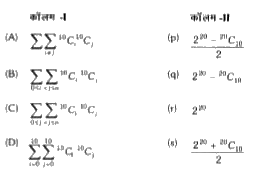यदि h(a) = h(b) , तो ∫ba[f(g(h(x)))]−1f'(g(h(x))g'(h(x))h'(x)dx=
0
f(a)−f(b)
f(g(a))−f(g(b))
इनमें से कोई नहीं
The correct Answer is:A
Step by step video, text & image solution for यदि h(a) = h(b) , तो int_(a)^(b)[f(g(h(x)))]^(-1)f'(g(h(x))g'(h(x))h'(x)dx= by Maths experts to help you in doubts & scoring excellent marks in Class 12 exams.
Updated on:21/07/2023Topper's Solved these Questions
- निश्चित समाकलन एवं वक्रों से घिरा क्षेत्रफल Book:ERRORLESS HINDIChapter:निश्चित समाकलन एवं वक्रों से घिरा क्षेत्रफल Exercise:JEE ADVANCED (More than one correct answers)
Explore 24 Videos
- निश्चित समाकलन एवं वक्रों से घिरा क्षेत्रफल Book:ERRORLESS HINDIChapter:निश्चित समाकलन एवं वक्रों से घिरा क्षेत्रफल Exercise:JEE ADVANCED (Reasoning type questions)
Explore 8 Videos
- निश्चित समाकलन एवं वक्रों से घिरा क्षेत्रफल Book:ERRORLESS HINDIChapter:निश्चित समाकलन एवं वक्रों से घिरा क्षेत्रफल Exercise:SOLVED MULTIPLE CHOICE QUESTIONS (वक्रों द्वारा परिबद्ध क्षेत्रफल )
Explore 97 Videos
- द्विपद प्रमेय तथा गणितीय आगमन Book:ERRORLESS HINDIChapter:द्विपद प्रमेय तथा गणितीय आगमन Exercise:JEE Advanced (Matrix Math type questions)
Explore 5 Videos
- प्रायिकताBook:ERRORLESS HINDIChapter:प्रायिकताExercise:EXERCISE
Explore 99 Videos
Similar Questions
यदि In=∫π−πsinnx(1+πx)sinxdx , n = 0 , 1, 2 ..........., तब
View Solutionकथन-1 : समाकलन ∫π/3π/6dx1+√tanx का मान π/6 है
कथन-2 : ∫baf(x)dx=∫baf(a+b−x)dx
View Solutionवक्र y=xex2 , x- अक्ष तथा कोटियों x = 0, x = a से घिरा क्षेत्रफल है
View Solutionनिम्नलिखित कॉलम I को कॉलम II से मिलाये

View SolutionA, B, C तीन परस्पर स्वतंत्र घटनायें हैं। S1 तथा S2 दो कथनों को देखने पर
S1 : A तथा B∪C स्वतन्त्र हैं
S2 : A तथा B∩C स्वतन्त्र हैं तब
View SolutionLet f,g,h be differentiable functions of x. if Δ=∣∣ ∣ ∣∣fgh(xf)'(xg)'(xh)'(x2f)''(x2g)''(x2h)''∣∣ ∣ ∣∣and,Δ'=∣∣ ∣ ∣∣fghf'g'h'(xnf'')'(xng'')'(xnh'')'∣∣ ∣ ∣∣, then n =
View SolutionIf h(a)=h(b), the value of the integral
∫ba[f(g(h(x))]−1f'(g(h(x)))g'(h(x))h'(x)dxis equal to
View SolutionIf f(x)=x−1,g(x)=3x,andh(x)=5x , then f−1(g(h(5)))=
View SolutionIf f(x) be a function such that f(−x)=−f(x),g(x) be a function such that g(−x)=−g(x) and h(x) be a function such that h(−x)=h(x), then choose the correct statement:
I. h(f(g(−x)))=−h(f(g(x)))
II. f(g(h(−x)))=f(g(h(x)))
III. g(f(−x))=g(f(x))
View SolutionIf f(x)=ex,g(x)=Sin−1xandh(x)=f(g(x)), then h'(x)h(x)=
View SolutionIf f(x)=(g(x))+g(−x)2+2[h(x)+h(−x)]−1 where g and h are differentiable functions then f'(0)
View SolutionIf f(x),g(x)sin^(-1)x And h(x)=f(g(x)) , Then h'(x)//h(x)=
View Solutionयदि f(x)=ex,g(x)=sin−1x और h(x)=f(g(x)), तब h'(x)/h(x)=
View SolutionAssertion (A) : If f(x) , g(x) and h(x) are continueous on [a,b] and differentiable in (a,b) , then, the exists c∈(a,b) such that ∣∣ ∣ ∣∣f(a)g(a)h(a)f(b)g(b)h(b)f'(c)g'(c)h'(c)∣∣ ∣ ∣∣=0
Reason ( R ) : Lagrange's Mean Value theorem is applicable on [a,b] for ϕ(x)=∣∣ ∣ ∣∣f(a)g(a)h(a)f(b)g(b)h(b)f'(c)g(x)h(x)∣∣ ∣ ∣∣=0
Then , which of the following is true?
View Solutionf(x)=x,g(x)=1x and h(x)= f(x) g(x). If h(x) = 1 then…….
View Solution